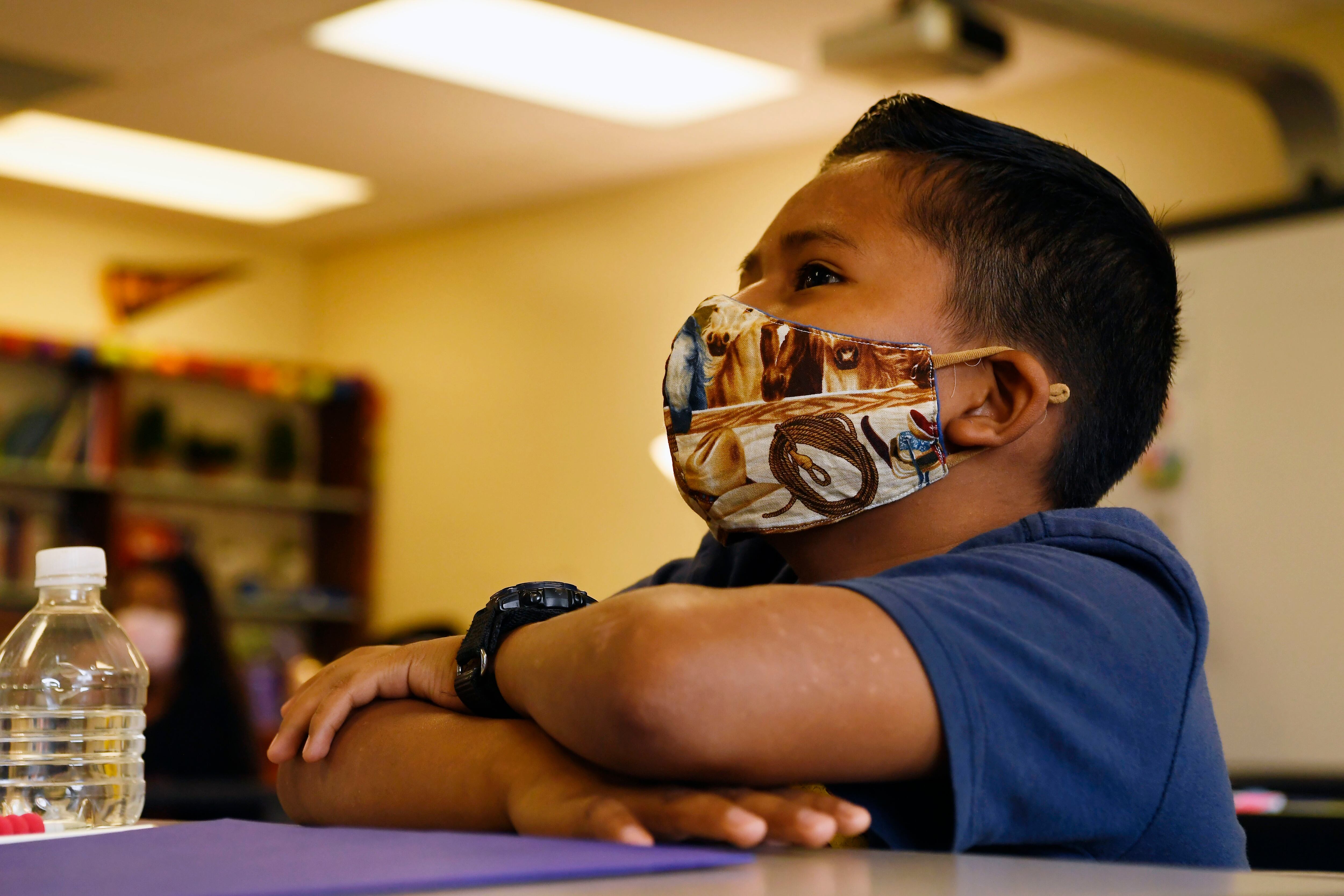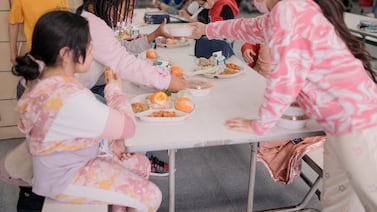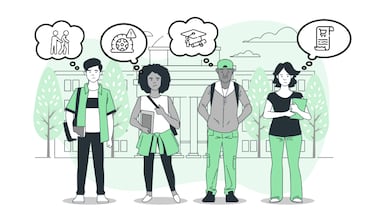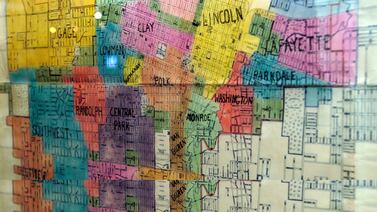Two rows of middle school students, each with their backs against opposing walls, stood on spaced out “X”s in the hallway at North Middle School in Aurora on Friday.
There they practiced speaking English — using full sentences as they had just learned in class.
“Hi. My name is…” they practiced saying to their partner standing on the opposite wall. They asked each other questions. And then responded with sentences that described how they felt about returning to school.
“I feel excited about returning to school,” students said.
Newcomer students, those who have been in the U.S. less than a year, are getting the chance to go into school buildings once a week in Aurora, where all students are learning virtually through the first quarter. The Aurora district is planning for students to return part time to school buildings under a hybrid model in mid-October.
The Aurora school board had asked the district to find ways to allow some high-risk students to get in-person learning. The district invited newcomer students as well as students with disabilities and students at Pickens Technical College — where many trade classes require hands-on learning — to come to classrooms.
Across the country, schools have identified immigrant students and other English language learners as particularly struggling with remote learning and therefore at risk of bigger learning losses. These students are more likely to lack internet access or help from parents to navigate their virtual classroom from home.
Of the newcomer students in Aurora schools, 236 have taken up the offer and started attending in-person groups. Each group is limited to 10 students. Students still do the majority of their learning online, but have a 45-minute in-person lesson once a week for English language development.
The district is also serving 353 students with special needs, with most attending in-person three or four days per week, as well as more than 1,000 students who are taking classes at Pickens attending on alternating weeks.
At North, the school had identified and invited 10 newcomer students to participate. Of those, six have accepted, and are working with two co-teachers.
Students arrive at school around 11:15 a.m. and can grab a sack lunch outside to eat in the classroom before the lesson starts. On Friday, teachers offered a lesson that wasn’t easy to replicate online.
That was the practice of speaking to each other in the hallway, a strategy known as “lines of communication,” which helps students practice a typical conversation in English.
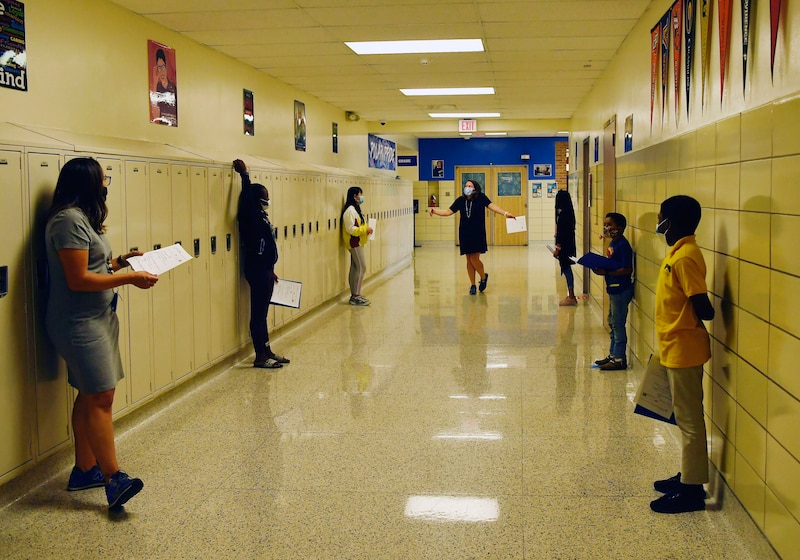
“These are the kinds of things that happen in a classroom,” said Cara LaMark, the school’s culturally and linguistically diverse education teacher leader. When a teacher asks students how they are doing, students now will have a template for how they might respond, she told them.
Small group interaction is what’s most difficult to facilitate online, LaMark said. The district this year is using Google Classroom for live video instruction, but the platform does not have a simple way to break out students into small groups within the meeting.
LaMark said she’s not worried that students will lose their gains toward English fluency, but thinks that their progress will be different than before virtual learning. Now, for example, students do a lot more writing, but practice less speaking, than when classes were all in person.
Ashlee Saddler, Aurora’s director of culturally and linguistically diverse education, said teacher surveys showed concern for newcomer students. The district also heard from Aurora’s Welcome Center, where staff was spending a lot of time troubleshooting problems to help families and students access remote learning.
The Aurora school district, one of the most diverse in the state, serves students from all over the world. The district could not provide a total number of newcomer students that were invited to participate in the small groups, since that was up to each school. The district extended invitations in multiple languages, but officials said they didn’t pressure any family to send their children to school.
And Saddler said that the district didn’t have a great way to estimate how many students would participate.
Of the district’s more than 40,000 students last year, almost 40% were identified as English language learners. Trying to bring in all English learners for in-person instruction would have been challenging, officials said.
“The other goal is really around making students feel more comfortable,” Saddler said. “It really is designed to support them and to give them language they can use throughout the day.”
At some Aurora schools, Saddler said that teachers doing in-person lessons have been able to identify other student needs to help them access remote learning, including connecting them with resources to get low-cost internet.
LaMark said that at North, teachers aren’t aware of students who are still struggling with a lack of a connection. However, she said, the school has been able to provide some students with headsets, to help them focus when there are multiple siblings doing virtual learning in close quarters at home.
Besides the English language practice students got on Friday at North Middle School, teachers also asked students to log onto their Google Classroom and asked each one if they needed help, if they knew where to find their coursework and links for live class meetings, or if they felt their coursework that week had been too difficult.
Four of the five students stayed after class to get extra help.
One student who had just joined the in-person group had not participated in remote learning all week. LaMark said she hoped that by meeting with her in person, she may feel more encouraged to participate in other classes.
“We’re seeing so many benefits from students being able to have that contact with the teacher,” Saddler said.
Correction: This story was updated to reflect that six students at North Middle School are participating in the in-person classes.


